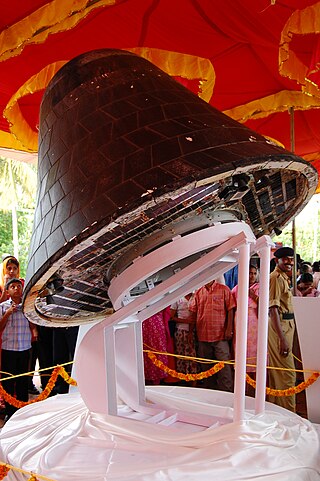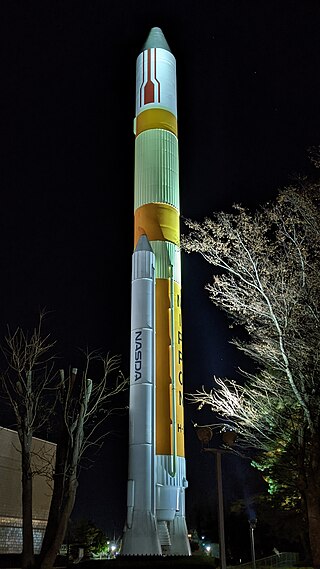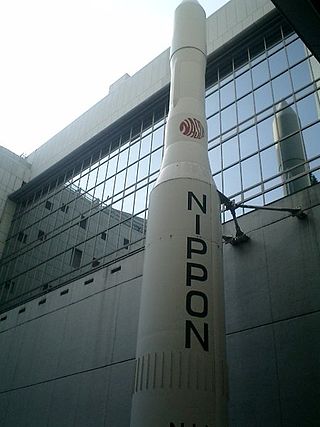
Ariane 5 is a European heavy-lift space launch vehicle developed and operated by Arianespace for the European Space Agency (ESA). It is launched from the Centre Spatial Guyanais (CSG) in French Guiana. It has been used to deliver payloads into geostationary transfer orbit (GTO) or low Earth orbit (LEO). The launch vehicle had a streak of 82 consecutive successful launches between 9 April 2003 and 12 December 2017. Since 2014, Ariane 6, a direct successor system, is in development.

The Japan Aerospace Exploration Agency (JAXA) is the Japanese national air and space agency. Through the merger of three previously independent organizations, JAXA was formed on 1 October 2003. JAXA is responsible for research, technology development and launch of satellites into orbit, and is involved in many more advanced missions such as asteroid exploration and possible human exploration of the Moon. Its motto is One JAXA and its corporate slogan is Explore to Realize.

H-IIA (H-2A) is an active expendable launch system operated by Mitsubishi Heavy Industries (MHI) for the Japan Aerospace Exploration Agency. These liquid fuel rockets have been used to launch satellites into geostationary orbit; lunar orbiting spacecraft; Akatsuki, which studied the planet Venus; and the Emirates Mars Mission, which was launched to Mars in July 2020. Launches occur at the Tanegashima Space Center. The H-IIA first flew in 2001. As of December 2021, H-IIA rockets were launched 45 times, including 39 consecutive missions without a failure, dating back to 29 November 2003.

Akatsuki, also known as the Venus Climate Orbiter (VCO) and Planet-C, is a Japan Aerospace Exploration Agency (JAXA) space probe tasked with studying the atmosphere of Venus. It was launched aboard an H-IIA 202 rocket on 20 May 2010, but failed to enter orbit around Venus on 6 December 2010. After the craft orbited the Sun for five years, engineers successfully placed it into an alternative Venusian elliptic orbit on 7 December 2015 by firing its attitude control thrusters for 20 minutes and made it the first Japanese satellite orbiting Venus.

This article outlines notable events occurring in 2006 in spaceflight, including major launches and EVAs. 2006 saw Brazil, Iran, and Sweden all get a national into space for the first time.

The year 2007 contained several significant events in spaceflight, including a Chinese ASAT test, the launches of the US Phoenix and Dawn missions to study Mars and Asteroid belt respectively, Japan's Kaguya Lunar orbiter, and the first Chinese Lunar probe, Chang'e 1.

The H-II (H2) rocket was a Japanese satellite launch system, which flew seven times between 1994 and 1999, with five successes. It was developed by NASDA in order to give Japan a capability to launch larger satellites in the 1990s. It was the first two-stage liquid-fuelled rocket Japan made using only technologies developed domestically. It was superseded by the H-IIA rocket following reliability and cost issues.

The N-I or N-1 was a derivative of the American Thor-Delta rocket, produced under license in Japan. The N stood for "Nippon" (Japan). It used a Long Tank Thor first stage, a Mitsubishi Heavy Industries-designed LE-3 engine on the second stage, and three Castor SRMs. Seven were launched between 1975 and 1982, before it was replaced by the N-II. Six of the seven launches were successful, however on the fifth flight, there was recontact between the satellite and the third stage, which caused the satellite to fail.
The N-II or N-2 was a derivative of the American Delta rocket, produced under licence in Japan. It replaced the N-I-rocket in Japanese use. It used a Thor-ELT first stage, a Delta-F second stage, nine Castor SRMs, and on most flights either a Star-37E or Burner-2 upper stage, identical to the US Delta 0100 series configurations. Eight were launched between 1981 and 1987, before it was replaced by the H-I, which featured Japanese-produced upper stages. All eight launches were successful.

The year 2011 saw a number of significant events in spaceflight, including the retirement of NASA's Space Shuttle after its final flight in July 2011, and the launch of China's first space station module, Tiangong-1, in September. A total of 84 orbital launches were conducted over the course of the year, of which 78 were successful. Russia, China and the United States conducted the majority of the year's orbital launches, with 35, 19 and 18 launches respectively; 2011 marked the first year that China conducted more successful launches than the United States. Seven crewed missions were launched into orbit during 2011, carrying a total of 28 astronauts to the International Space Station. Additionally, the Zenit-3F and Long March 2F/G carrier rockets made their maiden flights in 2011, while the Delta II Heavy made its last.
The Institute for Unmanned Space Experiment Free Flyer (USEF) (財団法人無人宇宙実験システム研究開発機構) was a Japanese space agency, which was founded by the Ministry of International Trade and Industry in 1986. Unlike NASDA, ISAS, and NAL, it was not included in the JAXA organization, which was founded in 2003. The chairperson is Ichiro Taniguchi.

IKAROS is a Japan Aerospace Exploration Agency (JAXA) experimental spacecraft. The spacecraft was launched on 20 May 2010, aboard an H-IIA rocket, together with the Akatsuki probe and four other small spacecraft. IKAROS is the first spacecraft to successfully demonstrate solar sail technology in interplanetary space.
Waseda-SAT2 is a Japanese satellite which launched in May 2010. It is a student-built spacecraft, which will be operated by Waseda University, and is intended to be used for Earth observation and technology demonstration. It will test the use of extendible paddles to provide attitude control. The satellite is a single unit CubeSat.
Negai☆″ is a Japanese satellite which launched in May 2010. It is a student-built spacecraft, which will be operated by Soka University, and is intended to be used for technology demonstration. The satellite is a single unit CubeSat, and will be used to test a field programmable gate array in orbit. As part of an outreach programme, it will carry the names of selected children, along with wishes they have made. The satellite will return images of the Earth, which will be given to the participating children.

In 2014, the maiden flight of the Angara A5, Antares 120 and Antares 130 took place.

Several new rockets and spaceports began operations in 2016.

The Epsilon Launch Vehicle, or Epsilon rocket, is a Japanese solid-fuel rocket designed to launch scientific satellites. It is a follow-on project to the larger and more expensive M-V rocket which was retired in 2006. The Japan Aerospace Exploration Agency (JAXA) began developing the Epsilon in 2007. It is capable of placing a 590 kg payload into Sun-synchronous orbit.
Space Tethered Autonomous Robotic Satellite II or STARS-II, was a nanosatellite built by Japan's Kagawa University to test an electrodynamic tether in low Earth orbit, a follow-on to the STARS mission.

This article documents notable and expected spaceflight events during the year 2023.













